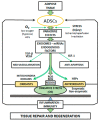The Crosstalk of Adipose-Derived Stem Cells (ADSC), Oxidative Stress, and Inflammation in Protective and Adaptive Responses
- PMID: 33291664
- PMCID: PMC7730805
- DOI: 10.3390/ijms21239262
The Crosstalk of Adipose-Derived Stem Cells (ADSC), Oxidative Stress, and Inflammation in Protective and Adaptive Responses
Abstract
The potential use of stem cell-based therapies for the repair and regeneration of various tissues and organs is a major goal in repair medicine. Stem cells are classified by their potential to differentiate into functional cells. Compared with other sources, adipose-derived stem cells (ADSCs) have the advantage of being abundant and easy to obtain. ADSCs are considered to be tools for replacing, repairing, and regenerating dead or damaged cells. The capacity of ADSCs to maintain their properties depends on the balance of complex signals in their microenvironment. Their properties and the associated outcomes are in part regulated by reactive oxygen species, which mediate the oxidation-reduction state of cells as a secondary messenger. ADSC therapy has demonstrated beneficial effects, suggesting that secreted factors may provide protection. There is evidence that ADSCs secrete a number of cytokines, growth factors, and antioxidant factors into their microenvironment, thus regulating intracellular signaling pathways in neighboring cells. In this review, we introduce the roles of ADSCs in the protection of cells by modulating inflammation and immunity, and we develop their potential therapeutic properties.
Keywords: adipose derived stem cells; oxidative stress; stem cells; tissue protection.
Conflict of interest statement
The authors declare no conflict of interest.
Figures

References
-
- Fu X., Xu Y. Self-renewal and scalability of human embryonic stem cells for human therapy. Regen. Med. 2011;6:327–334. - PubMed
-
- Barlow S., Brooke G., Chatterjee K., Price G., Pelekanos R., Rossetti T., Doody M., Venter D., Pain S., Gilshenan K., et al. Comparison of human placenta- and bone marrow-derived multipotent mesenchymal stem cells. Stem Cells Dev. 2008;17:1095–1107. - PubMed
Publication types
MeSH terms
Substances
LinkOut - more resources
Full Text Sources

